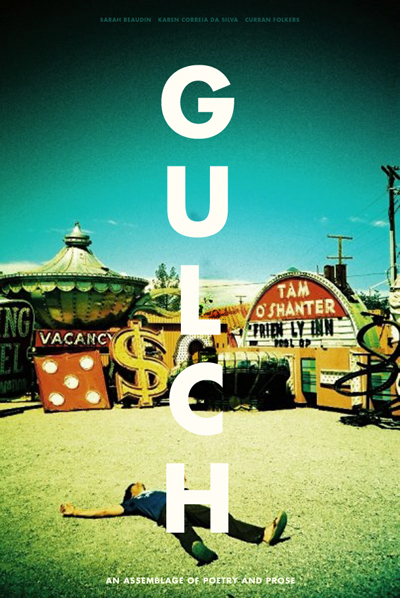Overlapping interests — young writers, the urban landscape and subversive art — guided the Toronto’s Steel Bananas art collective in producing GULCH: An Assemblage of Poetry and Prose. The book’s form, content and process were also inspired by Gilles Deleuze and Felix Guattari’s rhizome theory, where people and ideas are encouraged to be non-hierarchical and non-linear. Botanically, rhizomes grow horizontally, and their offshoots can begin and end anywhere.
The first entry, “Poemagogy” by Adebe D.A., which includes many of the words used to describe this project — assemblage, rhizomes, roots, multiple, multiplicities — sets the reader up for fragmented movement, snapshots of cityscapes and a tension between recollection and imagining. It also begins the first of GULCH‘s three sections: Objects, Food and Rooms. I’m not sure why these are here. There’s a story about Nazi chickens attacking animal rights activists in a fast food restaurant in the Food section, but this was the strongest connection I could make.This structure is the same as Gertrude Stein’s Tender Buttons. While Stein’s work is seen by many as nonsensical, the contents of her sections are rather straightforward; in an introduction to a Canadian edition, Steve McCaffery describes Objects, Food and Rooms as “things externally perceived, things eventually absorbed, and the enclosed space in which the two other features are contained.” While this expands the possibilities of what might be included, I’m still not convinced this structure benefits GULCH. Furthermore, why does a book whose prologue asks, “Why is a model still necessary?” base itself on someone else’s organization? Unless the editors were using Stein as a rhizome to shoot off of.
Though GULCH doesn’t strive for a sense of continuity, there are recurring tempos and themes. Many of the short stories explore the present and future roles of technology. In “Like a Parade, Except No One Was Smiling,” author Chris Eaton wrote daily microfictions on Twitter, and invited users to reply with their own stories using at least one third of the words from the original. Selected responses were printed with Eaton’s stories in an intriguing and awkward mash of fonts and alignments. Amanda Lee’s “Twitches” is written as though it’s taking place online: characters are known by their avatars, and dialogue looks like a chat room discussion. Other works rally against technoculture. Azalea, a woman who takes some time to reflect on her life by revisiting an earlier one in Ursula Pflug’s “No Woman Is An Island,” declares that “we hide behind machines so we don’t have to look” at the potential dangers of our lives.
The science fiction stories were my favourite, perhaps because the fantastical is most effective when built within a believable reality. This genre requires writers to know the places and characters they’re writing about, as well as their intentions — something that I felt was missing from other writing, or withheld. I don’t consider myself a reader who demands linearity, but this book made me re-examine that idea; how does one engage with writing that is intentionally going nowhere or starting from nothing? The language is rich; I was often a little lost; the formatting changes with the content; and there are lots of typos (how does one edit in a non-linear, non-hierarchical way?).
The rhizomatic-multiplicities approach is not always directly addressed by the pieces of this collection. Instead, some writing is born out of play or anger or fantasy or fact — concrete poetry, cell phone transcripts, love stories, mysteries. Over the course of 52 writers, I alternated between absorbed and frustrated, but the reliability of GULCH is the space it provides for new visions, new styles and new writers.–Samantha Sternberg
Samantha Sternberg is a Halifax-based writer.




